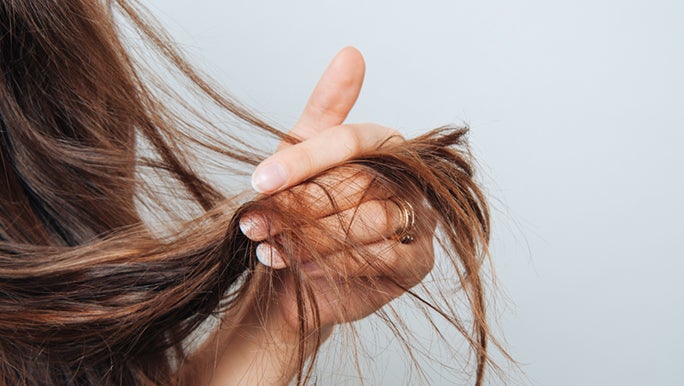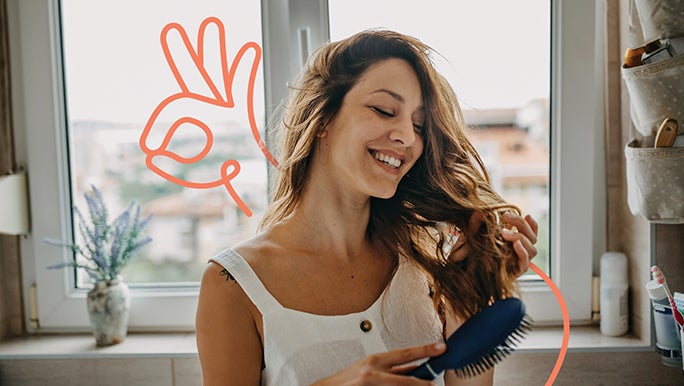Your hair should be your crowning glory – and keeping your hair shiny and beautiful plays a huge role in looking and feeling your best.
But every day, you could be damaging your hair without even realising it. Whether you have curly or straight hair, long or short, certain actions can damage it – leaving it dry, split and lifeless.
To help, we’ve researched the top causes of damaged hair and what you can do to help fix them.
Using the wrong products for your hair
Different types of hair require different products. Whether you need to control oily roots or tame your wild curls, until you know what you’re dealing with, you can’t find the right products.
Identify your hair type
Looking after your skin starts with identifying your skin type, and you need to do the same for your hair. healthline has an excellent guide to deciphering your hair type.

Looking after your skin starts with identifying your skin type, and you need to do the same for your hair.
Assuming your dry, flaky scalp is dandruff
Dandruff and a dry, flaky scalp do share symptoms (scalp flakes) but they’re different conditions, and they require different treatments. Using the wrong treatment won’t help – and might even make symptoms worse.
Identify your flakes
A dry scalp produces small, drier flakes. Using a light moisturiser on your scalp overnight should help them disappear after your morning shower.
Dandruff flakes are larger and oily. One theory is that this is because they’re the result of your hair follicles producing too much oil, which then gets trapped under dead skin.
If you have oily skin and pimples at any age, those flakes are probably dandruff. Look for a medicated shampoo that’s specifically for dandruff and contains zinc or selenium to gently slough away the dead skin.
Brushing when wet
It’s so easy to grab the nearest hairbrush when you step out of the shower to get any lingering knots out. Unfortunately, hair is thought to be most fragile when it’s wet, so this can lead to splitting and breakage.
Use a wide-toothed comb first
When you apply conditioner, use a wide-toothed comb to distribute it evenly and get all the knots out before rinsing.
Then, once you’re out of the shower, wait until your hair is at least half dry before using a brush. And try not to be too savage!

No matter what hair type you have, use lukewarm water to wash it, this helps to close the cuticles and give you shiny hair.
Using hot water to wash
Overly hot water can strip the natural oils from your hair, leaving it dull and lifeless.
Keep it cool
No matter what hair type you have, use lukewarm water to wash it, then finish your final rinse with water as cold as you can stand. This helps to close the cuticles and give you shiny hair.
Washing your hair every day
If your hair is greasy or your scalp is itchy and flaky, it's easy to try to control it by washing your hair every day. But for some people, that could make the symptoms worse.
Your hair produces its own natural oils to keep it healthy, and washing every day strips those oils. This can make hair even more greasy as the follicles try to compensate. Excess oils around the hairline can also contribute to pimples – especially for teenagers.
Invest in a dry shampoo
Unless you have very fine hair or dandruff, it’s OK to wash every two or three days. If your roots feel oily the next day, try using a dry shampoo to target the roots and keep the oil under control.
Bonus top 5 healthy hair tips
Once you have damage control underway, follow our top 5 tips to keep your hair healthy, shiny and beautiful.
- Nourish from the inside. Keratin can help keep hair healthy and strong. Check out our top 10 foods for healthy hair to see what to include in your diet.
- Swap your cotton pillowcase for silk. The smooth fabric can create less friction and therefore less frizz to your hair.
- Get regular haircuts. This might seem counterintuitive, but keeping on top of split ends can keep your hair looking healthy.
- Use a heat protectant product before using styling tools. This will add a protective layer against the heat and help to seal in moisture, which is essential if you have naturally dry frizzy hair.
- Consider sun protection for your hair. If you’re going to spend a long time outside, follow the Cancer Council’s suggestion to ‘slap on a hat’. It will protect your hair and scalp from those harmful UV rays.

Your hair produces its own natural oils to keep it healthy, and washing every day strips those oils. This can make hair even more greasy as the follicles try to compensate.
Of course, these tips are all general, so if you’re already doing them, it’s probably worth asking your hairdresser for some personally tailored advice.
They can assess your individual hair type, suggest the best products to use and let you know about any particular ingredients to stay away from.
Related:
Reviewed by the healthylife Advisory Board June 2021



